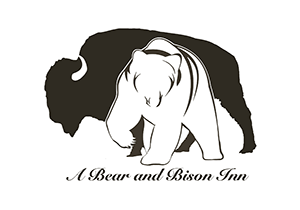February 26, 2022
Did Someone Paint That Lake Turquoise?
Sue Slaght – Travel Tales of Life
The beauty is surreal. Gleaming in sunlight, it is as if turquoise gems have dissolved into the glacial lake waters. Tourists and locals alike, find it challenging to pull their eyes from the mesmerizing shades of the mountain waters.
“How do they make the water look that way?”
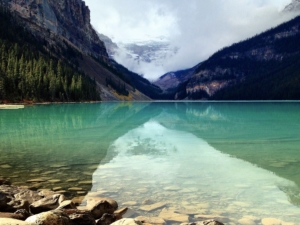
Puzzled visitors gaze about, hoping someone might explain the turquoise phenomenon. As an April Fools joke, Travel Alberta once sent out a press release, describing how the bottom of Lake Louise is painted each year to achieve the gorgeous shade, Lake Louise Turquoise Blue.
Going so far as to release edited photos of a drained lake and painting underway, the internet went viral with the story. Apparently, few checked the calendar to see it was the annual day for hoaxes and pranks.
Once the jest ran its course, Travel Alberta admitted the lake is not painted yearly. The pop-your-eyeballs turquoise shade remains none the less.
“So then why are those lakes turquoise?”
It turns out the answer is in the geological kitchen. The postcard perfect vista is courtesy of flour. Rock flour or glacial flour that is. While those dazzling blue-green lakes get all the attention, bedrock and glaciers are grinding up a beautiful recipe.
How can a glacier make flour?
It sounds more like a culinary experiment than geology in progress. Different than the baking challenges of managing yeast, and days of fermenting in producing perfect sourdough loaves, mountain glaciers, with their solid and reliable bedrock partners, produce glacial silt or flour, consistently.
During glacial migration, glacier flour is produced from the grinding against rock. As well, during the freeze-thaw cycle, water expands small cracks in the rock. Small particles break away and ultimately become part of the glacier flour recipe, turning mountain lakes into turquoise gems.
One might imagine the rocks beneath the glacier as the size of boulders or at least baseballs. However, the rock pieces ground into glacial rock flour are minute in size. Imagine a handful of dust, rather than pebbles, let alone baseballs.
Glacial silt or flour is the not-so-secret ingredient in creating turquoise mountain lakes. Perhaps not as tantalizing as the lake bottom painting story, but a marvel of geology.

Who mixes the flour in the lake?
Proper mixing is key to any fabulous recipe. As tempting as it is to imagine a giant stirring glacial lakes with an immense paddle, the mystery of why the lake is turquoise, is not answered in that fairy-tale.
As the glacier and bedrock work diligently creating the fine silt, melting mountain streams oversee transportation. Suspended in water, the tiny glacial flour particles create a murky or milky appearance.
Thus, it is glacial milk flowing into lakes where the recipe gets cooking.
Is the flour turquoise?
It would be logical to assume that the flour of our recipe is a vibrant aqua-marine shade. As melt water is deposited in spring and summer into the lakes, it seems reasonable that the mixing is what causes the colour.
In actuality, the rock flour is not turquoise. It is however incredibly fine, the particles being smaller than sand. Thus, the silt lies in suspension, in the upper layer of the glacial lake.
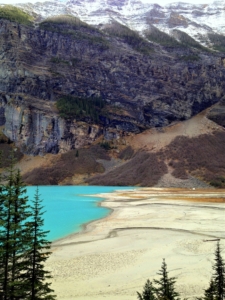
Sea water or lakes not fed by glaciers, absorb longer wavelengths of light that the human eye can see, such as red, orange, and yellow. Reflecting shorter wavelengths of blue and blue-green, unless there is something at the surface such as algae, we will see blue.
As glacier flour sits in suspension, creating an opaque upper surface, it produces a unique surface to reflect to our eyes. The flour has its own tricks, as it absorbs most of the blue light. So, with the water absorbing red, yellow, and orange, what is left for the human eye to see, is primarily green, with a tinge of blue.
Although the flour is not turquoise, the eye-popping result of the glacial process creates the turquoise lakes.
What is the best time to see a turquoise lake?

The turquoise shade is best seen on a cloudless day. The sunlight on a clear day, best reflects the glacial flour, suspended in the upper layer of the lake, back to our eyes.
The more glacial milk that has streamed into the water, the more vibrant the turquoise colour looks to astounded visitors.
Unlike many locations in the northern hemisphere, most glacial lakes in Canada do not melt until late spring. For those showing off photos of tulips blooming in March, don’t expect glacial lakes to be free of ice until early June here in Alberta.
As meltwater, carrying glacial flour continues to run, ever more of turquoise causing ingredient feeds into the lakes. The recipe is a simple one at this point. The more silt from the bedrock and glacier grinding process deposited into the lake, the brighter the shade of turquoise.
The highest intensity of the glacier lake colours can be expected in July and August. However, visitors be warned. On a rainy or overcast day, even in prime time for glacial lake viewing, the turquoise shade will be less noticeable.

With the approach of fall in September, the flow of glacial silt slows. The trees of autumn steal the colour show from the glacial lakes as the turquoise shade fades once again.
Where can I see a glacial lake?
From Pakistan to New Zealand, these turquoise lakes are visible. The Alberta Rocky Mountains provide some of the most spectacular opportunities in the world to see the turquoise wonders of glacial flour.
As in kitchen recipes, the result lies in the ingredients utilized. With each glacier producing differing amounts of glacial flour, the resulting turquoise colour differs. Below is a sampling of the many glacial lakes in Alberta to visit.
Lake Louise
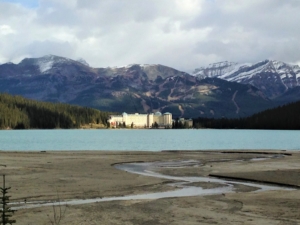
In the summer of 1882, a young employee of the Canadian Pacific Railway, Thomas Wilson, stood with two Stoney First Nations guides on the shores of the ‘Lake of Little Fishes’. Mesmerized by the blue-green waters he later reported, “I never, in all my explorations, saw such a matchless scene.”
He would be the first non-Indigenous person to glimpse Lake Louise, later named after Princess Louise Caroline Alberta (1848–1939), the fourth daughter of Queen Victoria.
By 1890, a simple single story log cabin had been constructed to receive guests on the shores of Lake Louise. In 1890, 50 guests had registered and by 1912 the count had risen to 50,000. This small summer cabin, through two fires and four architects, would evolve to today’s luxurious Fairmont Chateau Lake Louise.
During summer months Lake Louise is an extremely popular destination. Please consult the Banff Lake Louise Tourism site for information on Lake Louise shuttles, parking and planning your visit.
Moraine Lake
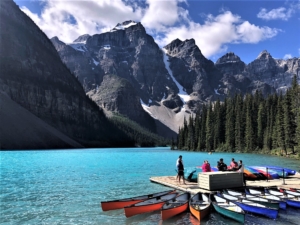
Sitting at an elevation of 1,885 metres (6,183 feet), Moraine Lake’s brilliant blue-green glacial waters attract worldwide attention. The ‘twenty-dollar view’ refers to the lake being featured on the reverse side of the Canadian twenty-dollar bill for a decade between the years of 1969-1979.
There are several hikes in the area, with the easiest being a walk along the lake shore. Most popular is the short climb of the Rockpile. There visitors are treated to the iconic glacial lake view.
The road to Moraine Lake is open only from late May/early June to the middle of October, depending on snow fall. The parking lot is often full prior to sunrise. Space is limited. For up-to-date shuttle information and planning your visit click here.
Grassi Lakes
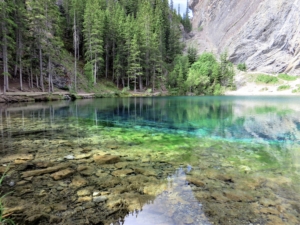
Grassi Lakes, their emerald-colored waters lying quietly above Canmore Alberta, is a popular hiking and rock-climbing destination. With mirror-like pools as the reward, the Grassi Lake hike is one of the most popular in the area.
The Grassi Lakes trail, built by Lawrence Grassi, begins gently wandering through forest and wildflowers. Grassi emigrated to Canada from Italy in 1912 initially working for the Canadian Pacific Railway and then later the Canmore coal mines. He became a sought-after climbing guide however is best known for his trail building.
Read More about Lawrence Grassi and his remarkable story. The Bow Valley’s Trailblazer
Family friendly, Grassi Lakes hiking can be congested, especially on summer weekends. To enjoy the turquoise pools without mobs of others, arrive early in the morning or early in the evening.
Peyto Lake
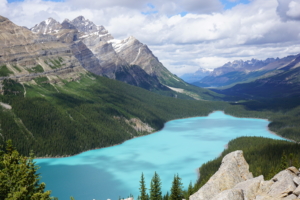
Another spectacular location to view glacial flour in action is is Peyto Lake, along the Icefields Parkway. Known as one of the most scenic road trips in the world, this vibrant turquoise lake is one of the popular stops, 40 kilometres or 25 miles north of Lake Louise.
Fed by Peyto Creek, carrying meltwater from the Wapta Icefield, it is one of the most photographed lakes in Banff National Park.
Read more from Sue Slaght
Why the Grizzly Crossed the Road, Alive!

